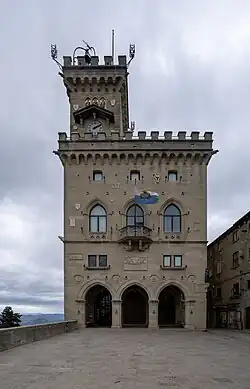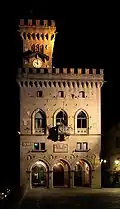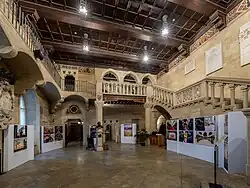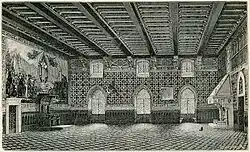Palazzo Pubblico (San Marino)
The Palazzo Pubblico (‘Public Palace’) is the city hall of the City of San Marino. It is where official state ceremonies take place, and it is the seat of the Republic's main institutional and administrative bodies: the Captains Regent, the Grand and General Council, the Council of XII, and the Congress of State.[1][2]
Architecture
The building is located on the site of an ancient building called the Domus Magna Comunis, which was the predecessor to the Palazzo Pubblico, built in the 14th century.[3] The current building was designed by the Roman architect Francesco Azzurri with construction beginning on 17 May 1884, and ending in 1894, with an inauguration ceremony taking place on 30 September 1894.[4]
Following a century of minimal alteration, concerns over the structure's safety and functionality warranted a complex restoration project. The intervention was completed by the internationally renowned architect Gae Aulenti and an inauguration ceremony for the newly restored building was held on 30 September 1996.[1]
The main section of the building is topped by battlements over a series of corbels. The clock tower above also features such an arrangement with battlements and corbels. The overall design is similar to the Palazzo Vecchio in Florence, but on a much smaller scale.[5]
Inside the Chamber of the Council of XII is a painting by Guercino entitled San Marino che benedice la città (English: San Marino blessing the city).[3]
Gallery
-
 Exterior of the Palazzo Pubblico
Exterior of the Palazzo Pubblico -
 The Palace at night
The Palace at night -
.jpg) The Palace in 1889, with the Statua della Libertà pictured in front of it
The Palace in 1889, with the Statua della Libertà pictured in front of it -
 Entrance in 2023
Entrance in 2023 -
 Entrance in 1900
Entrance in 1900 -
 Chamber of the Grand and General Council
Chamber of the Grand and General Council -
 Chamber of the Grand and General Council in 1900
Chamber of the Grand and General Council in 1900 -
 The mural of Saint Marinus in the Council’s chamber, with the seat of the captains regent in the foreground, in 1900
The mural of Saint Marinus in the Council’s chamber, with the seat of the captains regent in the foreground, in 1900 -
 Painting inside the Palace, "San Marino blessing the city" by Guercino
Painting inside the Palace, "San Marino blessing the city" by Guercino
References
- ^ a b "Palazzo Pubblico San Marino". SanMarinoSite. San Marino Site Turismo. 10 October 2014. Retrieved 8 May 2023.
- ^ "Palazzo Pubblico: Sede del governo e degli organi istituzionali". MuseiDiStato. Dipartimento Cultura e Turismo. Retrieved 8 May 2023.
- ^ a b "Palazzo Pubblico di San Marino | Palazzo del Governo". San Marino Web (in Italian). Retrieved 16 July 2025.
- ^ "Consiglio Grande e Palazzo Pubblico". Consiglio Grande Generale. Retrieved 16 July 2025.
- ^ Manufacturing Middle Ages: Entangled History of Medievalism in Nineteenth-Century Europe. Brill. 2013. p. 343. ISBN 978-90-04-24487-0.